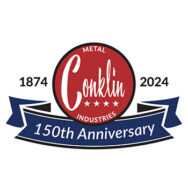According to Webster dictionary one of the definitions of “galvanized” is “the process of shocking or stimulating a muscle into action”. The definition we know is the second one listed: “to coat iron or steel with a protective layer of zinc”.
The term “hot dipped galvanized” is commonly referenced although many might not know what it means.
This is a very interesting process to watch in person. Here is how it works. The strip of steel passes thru a huge vat of molten (liquid) zinc. The steel is literally dipped in a “zinc bath” – much like you might dip a strawberry in a chocolate fountain!
While the steel is in the bath, the iron in the steel metallurgically reacts with the molten zinc to form a tightly bonded alloy coating that provides superior corrosion protection to the steel. The more zinc coating, the higher the corrosion resistance. There are gas powered air blowers called knives that blow off the excess zinc to achieve the desired coating weight. This works much like a hand drier in a public restroom.
Hot-Dip Galvanization process:
- Steel is cleaned to remove oil and grease, dirt, paint, and other materials
- Mill scale is removed from the steel after being pickled in an acidic solution and then rinsed
- Zinc ammonium chloride or another flux is applied to the steel (this inhibits oxidation of the surface that is cleaned once exposed to air). Flux helps the liquid zinc adhere to the steel
- After the flux has dried, the steel is dipped into molten zinc bath
- The steel is then cooled in a quench tank
Galvanizing steel provides corrosion resistance at a cheaper cost that stainless steel while providing a long life-cycle. The zinc coating on galvanized steel protects the metal, acting as a barrier between it and the atmosphere.
Fairly often we hear customers comment on their preference for the appearance of their galvanized metal. They are usually referring to the amount of spangle, which is a crystallization of the surface. This is an easy way to visually identify hot dip galvanization on steel. 20-30 years ago, the “big Spangle” was predominant. That has shifted over the years to zero or min spangle, which is how we order all of our steel these days.
